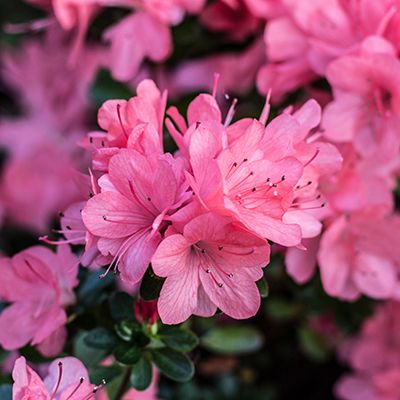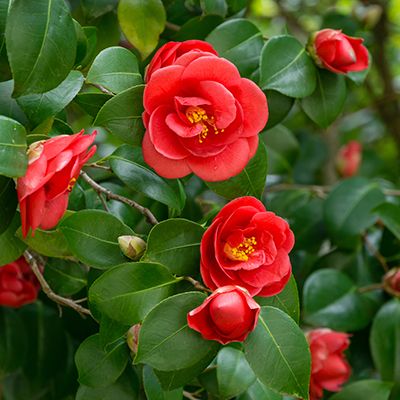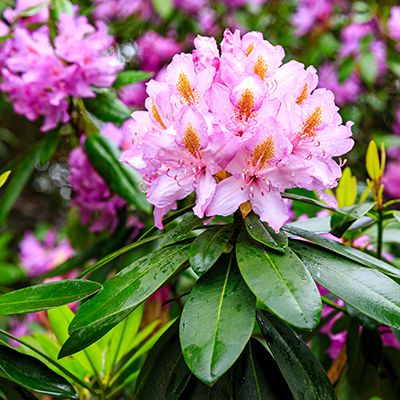


Azaleas
General Information: Prized as ornamental shrubs the world over, rhododendrons are renowned for their dramatic flower trusses, azaleas for their vibrant displays of color, and camellias for their perfectly formed, iridescent blossoms. In addition to their blossoms, all offer variety in shape and size and versatility in the landscape. Additionally, they also provide handsome evergreen foliage. Although rhododendrons and azaleas, both in the genus rhododendron, are from a different plant family than camellias, all require similar care and growing conditions in our area.
Light: Rhododendrons, azaleas and camellias all prefer three–four hours of direct sunlight in order to grow densely and bloom reliably. Because our summer sun can scorch even full sun plants, we recommend placement in morning or late afternoon sun or filtered light through the day. The "sun azaleas" (Southern Indica hybrids) and "sun camellias" (Camellia Sasanqua) will both generally withstand afternoon sun given adequate irrigation. None can tolerate 8-10 hours of full sun.
Water: Regular water is crucial to the health of rhododendrons, azaleas and camellias. Their shallow roots should be moist but not waterlogged. In the absence of natural rainfall, irrigation is especially important 1) immediately after planting, 2) after flowering during summer, when new leaves and flower buds are forming, 3) in fall, prior to winter dormancy, and 4) any period of a week to 10 days without at least one inch of rain. Mulching with Master Nursery® Forest Blend or Master Nursery® Forest Bark will help soils retain moisture as well as add acidity to the soil as the particles break down.
Soil Drainage: Rhododendrons, azaleas and camellias prefer well-drained soils that are slightly acid and humus-rich. If you're not sure how well your soil drains, dig a hole about a foot deep and fill it with water. Let it drain, and fill it again. If the water stays at the same level for several hours the second time, your soil has poor drainage. Fortunately, the plants are all shallow rooted and amending the top six to eight inches with two inches of Master Nursery® Bumper Crop, Master Nursery® Gold Rush or Master Nursery® Black Forest Blend will improve soil texture and drainage. Raised beds (six to12 inches) are a viable alternative. Mulching yearly with any of the products or with compost will also improve soil friability.
Soil pH: Avoid placing plants adjacent to concrete foundations or gravel paths containing alkaline materials such as concrete chips or oyster shells. Leaching alkaline minerals from a wall or path can stunt growth and even kill a plant unless you amend the soil. A good pH range for rhododendrons, azaleas and camellias is six to seven.
Wherever the soil is too alkaline, amend the soil with Master Nursery® Acid Planting Mix or Master Nursery® Gold Rush to reduce the pH. For established plants in alkaline soil, treat with iron sulfate or Master Nursery® Iron Plus. Follow this treatment with mulch of Master Nursery® Forest Bark or Master Nursery® Black Forest Blend. To keep the soil from becoming alkaline again, fertilize with Master Nursery® Camellia, Azalea, Gardenia and Rhododendron Food or Gardner & Bloome® Rhododendron, Azalea and Camellia Fertilizer. If these plants are located next to the house foundation, a spring treatment with iron sulfate will help to neutralize alkalinity from the concrete.
Planting: More rhododendrons, camellias and azaleas die from being planted too deep than from any other cause. To plant each shrub, dig a hole one to two feet wider than the root ball and no deeper than the depth of the soil in the container. Mix in Master Nursery® Gold Rush or Master Nursery® Acid Planting Mix to the soil removed from the hole at a ratio of one-third amendment to two-thirds native soil combined with Master Nursery® Master Start Fertilizer. Place the root ball in the hole so that its soil level is even with or slightly above the native soil level. Fill the space around the sides with the amended soil mixture until the hole is about half full and fill with water. Then, fill up the hole completely and
water it again. This will settle the soil as well as wet it through. Next, build an irrigation basin around the plant. Make sure the level of the basin is flush with or slightly above the level of the surrounding soil. Avoid sites exposed to cold or constant winds–especially with rhododendrons and camellias. When planting in containers use Master Nursery® Acid Planting Mix directly for optimal growth and fertilize every month.
Fertilizing: Rhododendrons, azaleas and camellias will benefit best from granular fertilizers specially formulated for acid-loving plants, such as: Master Nursery® Camellia, Azalea, Gardenia and Rhododendron Food or Gardner & Bloome® Rhododendron, Azalea & Camellia Fertilizer. Fertilizing should occur three times a year; right after bloom, one month later, and two months after the first application. A supplemental feeding of Master Nursery® Master Bloom™ can be applied in September to enhance flower blossom production. You may also need to apply Master Nursery® Iron-Plus or Master Nursery® Iron Sulfate if your plants show symptoms of iron deficiency.
Pruning: Because rhododendrons, azaleas and camellias begin to develop green growth and next season's flower buds right after bloom, this is the best time to prune. Azaleas are the easiest to prune, responding well to shearing or clipping. Rhododendrons should be pruned directly above a leaf node or deadheaded to encourage new branching. Some enthusiasts then pinch out the developing leaf buds to promote the formation of several leaf buds, ultimately yielding a denser plant. Camellias should be pruned to leaf nodes facing away from the center of the plant. Camellias can also be sheared, but should be thinned every other year to promote air circulation within the plant. Since all have growth nodes in wood up to eight years old or so, they can be pruned hard to force or to restore bushiness. To restore old plants, consult a pruning professional. Camellias can be pruned to produce a formal hedge and will bloom at the normal time.
Diseases: The flower petals and flower buds on camellias and azaleas will often turn brown when the rainy season begins. The browning is due to a fungus disease (camellia petal blight or azalea flower blight) and can be controlled on azaleas. All infected azalea petals must be picked and disposed of and the plants must be sprayed with a fungicide such as Bonide®Fung-onil™ before the rainy season begins.
There is no completely successful control for camellia petal blight. Remove and dispose of any brown tinged petals or flower buds before they fall off the plant, pick up and dispose of any flowers on the ground. These procedures may help to break the cycle of infection.
Occasionally azaleas will contract leaf galls, a fungus disease. A portion of the leaf swells and forms a grey-green swollen growth with a powdery coating (spores). The spores spread by splashing water or by being windblown. The galls must be removed and disposed of (DO NOT COMPOST). Next spring, spray with Monterey Liqui-Cop® or Bonide®Fung-onil™ (one tablespoon per gallon of water) before the buds open and at two week intervals until new leaves are fully grown.
Insects: Aphids can be controlled with Safer® Brand Insect Killing Soap or any insecticide. Thrips and black vine weevils may attack azaleas and rhododendrons. Thrips cause silvering of leaves and black specks on the back side. Weevil cause scalloping of rhododendron leaves. Both can be controlled with Bonide® Captain Jack’s DeadBug Brew (Spinosad), Ortho®MAX® Malathion Insect Spray (Malathion) or GardenTech Sevin (Sevin).